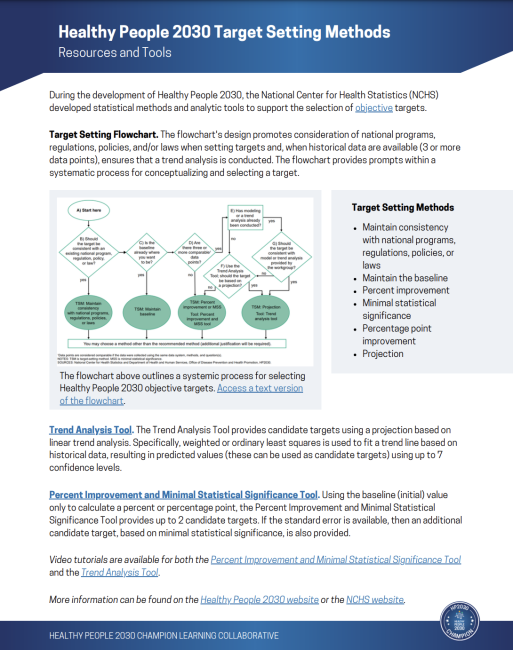The National Center for Health Statistics (NCHS) developed statistical methods and analytic tools to help with the selection of targets for Healthy People 2030. Federal subject matter experts serving on the Healthy People 2030 workgroups were responsible for selecting targets. These experts used data-driven approaches whenever possible, but they also considered subject matter expertise, public health policies, and agency or national priorities.
The process for setting Healthy People 2030 targets is intended to be transparent and replicable. A target-setting method justification is required for every core Healthy People 2030 objective and will be available on the Data Methodology and Measurement page for each objective in the coming months.
To learn more about the history of target setting in Healthy People and the technical details behind the percent improvement, percentage point improvement, projection, and minimal statistical significance methods for Healthy People 2030, check out the NCHS Statistical Note on Target-Setting Methods in Healthy People 2030 [PDF - 479 KB]. To access the tools and learn how to use them, check out the NCHS Target Setting page.
The target-setting methods for Healthy People 2030 are:
- Percent improvement
- Percentage point improvement
- Projection
- Minimal statistical significance
- Maintain consistency with national programs, regulations, policies, or laws
- Maintain the baseline
Percent improvement
For a percent improvement, the baseline is multiplied by a specific percentage, and the resulting value is added to or subtracted from the baseline. In Healthy People 2030, improvements of 10 or 20 percent from the baseline are most commonly used. Percent improvements other than 10 to 20 percent are used for a limited number of objectives. When available, the baseline standard error, or SE, is used to make sure the percent improvement would represent a statistically significant improvement from the baseline.
Percentage point improvement
For a percentage point improvement, the baseline — itself a percentage — is improved by adding or subtracting a specific value, also known as a percentage point. For Healthy People 2030, percentage point improvement is determined using a directional effect size calculation. Targets for percentages are calculated using Cohen’s h effect size. Effect sizes h=0.1 and h=0.2 were chosen to correspond with 10 percent and 20 percent improvement, respectively, from a baseline of 50 percent. The baseline standard error, or SE, when available was used to make sure the percentage point improvement was a statistically significant improvement from the baseline.
Projection
The projection target-setting method can be based on trend analysis, statistical models, or both. Trend analysis involves examining historical data to estimate a trend that can be projected into the future. Statistical models can be used to predict a future outcome using additional input data such as population data, regional data, or outliers. Models can incorporate historical data points, covariates, contextual information, and computer simulations.
The most common projection used in Healthy People 2030 is a trend analysis using weighted or ordinary least squares to fit a trend line. In addition, because Healthy People 2030 objectives have a desired direction (increase or decrease), the confidence level of a one-sided prediction interval (for example, 25, 33, 50, 66, or 75) can be used as an indication of how likely it is that a target will be achieved based on the historical data, and the one-sided prediction interval can be used to set a target. Other projection methods are used for a limited number of objectives.
Minimal statistical significance
Targets are set using a minimally statistically significant change from baseline (at the 0.05 level of significance), assuming the same standard error, or SE, for the target as for the baseline. This target-setting method requires that the estimates have SEs.
Maintain consistency with national programs, regulations, policies, or laws
The target-setting method of maintaining consistency with national programs, regulations, policies, or laws allows the Healthy People workgroups to take federal agency programs and policies into consideration or to align with statistical analyses, including modeling or trend projections, conducted outside NCHS.
Maintain the baseline
The target-setting method of maintaining the baseline is used when an objective is already at a desired level nationally or because the objective is moving or expected to move in an undesirable direction.
To learn more about the methodology and history of the target-setting methods, check out the NCHS Statistical Note on Target-Setting Methods in Healthy People 2030 [PDF - 479 KB].

Learn more about Target
Setting Methods
The "Target Setting Methods: Resources and Tools" fact sheet provides strategies to help select Healthy People objective targets.